Share
Five Future Trends for 2024 on Sustainability and the Environment

In the ever-evolving landscape of environmental and sustainability trends, 2024 promises to be a pivotal year. Drawing insights from various sources, this article aims to shed light on the key trends that will shape the global environment and sustainability sectors in the coming year, and beyond.
1. The Rise of ESG Metrics
(Environmental, Social, and Governance)
In 2024, businesses will not just be about profits. The emphasis on ESG metrics will be more pronounced than ever. Companies will be judged not just by their financial performance but also by their impact on the environment, their social responsibility, and their governance structures, according to S&P Global [1]. This holistic approach to business evaluation will drive companies to be more transparent, ethical, and sustainable in their operations.
Environmental metrics look at how a company impacts our dear Mother Earth. We’re talking about things like carbon emissions, water usage, and waste management. It’s about asking, “Is this company treating the planet like a disposable coffee cup or a cherished heirloom?”
Social metrics, on the other hand, zoom in on how a company treats its people and the communities it operates in. Are they ensuring safe working conditions? Are they promoting diversity and inclusion? Are they being good neighbours or the obnoxious ones?
Lastly, Governance metrics are all about the nitty-gritty of a company’s internal operations. How is the company run? Are there checks and balances in place? Is the CEO making 300 times the average worker, or is there a fairer distribution of the pie?
Now, you might be thinking, “Sounds cool, but why all the fuss?” Well, here’s the twist: companies that score high on ESG metrics aren’t just saving the planet and being all-around good corporate citizens. They are also raking in the dough. A 2023 study by Frontiers in Environmental Science [2] has shown that companies with strong ESG performances tend to have better financial results, lower risks, and higher investor interest. So, it’s not just about feeling good; it’s about good business sense.
By 2024, the narrative will be clear: profits and planet are not at odds. In fact, they’re like that power couple everyone admires. Companies that embrace ESG metrics will find that doing good for the world can also mean doing well for their bottom line. And those that
don’t? Well, they might just find themselves struggling to keep up in a world that demands more than just profits.
2. The Greening of Financial Markets
The financial markets will see a significant shift towards green investments. There will be a surge in green bonds, sustainable loans, and other financial instruments that support environmentally-friendly projects, according to Schroders[3]. This trend will be driven by both regulatory pressures and increasing demand from investors who are keen on supporting sustainable initiatives.
As the effects of climate change become more evident and the demand for sustainable solutions grows, there’s a ton of money to be made in the green sector. Investors are realizing that sustainable investments aren’t just about saving polar bears (though that’s pretty awesome too); they’re about tapping into a booming market with massive growth potential. In other words, as Leve Global’s Managing Director, Dr. Auliana Poon, has asserted again and again, “It’s high time to shift our mindset. We need to stop seeing the environment as merely a problem to be solved but as an industry with great opportunities to generate wealth.”
On the flip side, companies that aren’t jumping on the green bandwagon will risk being left behind. As regulations tighten and consumers demand more eco-friendly products and services, businesses that aren’t investing in sustainable solutions will find themselves out of favour and out of profits.
Moreover, the planet benefits too. Every green bond issued or sustainable loan granted means more funds channelled into projects that combat climate change, protect our natural resources, and create a more sustainable future for all.
By 2024 and beyond, the financial markets won’t just be about numbers and charts. They’ll be about values, impact, and legacy. The greening of financial markets is a testament to a global shift in mindset, where profits and planet go hand in hand.
3. The Evolution of Sustainable Consumerism: Not Just a Trend, It’s a Lifestyle
Consumers in 2024 will be more informed and conscious about their purchasing decisions. There will be a strong preference for sustainable products, and brands that fail to adapt to this trend will find themselves out of favour. According to a survey from McKinsey & Co., 66% of all respondents and 75% of millennial respondents say that they consider sustainability when they make a purchase. This shift in consumer behaviour will drive businesses to adopt more sustainable practices and offer products that are eco-friendly.
Gone are the days when buying something was just about brand names or how shiny it looked on the shelf. As we approach 2024, consumers are evolving, and they’re looking for more than just a product; they’re looking for a statement, a purpose, a cause.
Sustainable consumerism is taking the world by storm and it’s all about making purchasing decisions based on the product’s environmental and social impact. It’s about choosing products that are made ethically, last longer, and have a minimal negative impact on our planet. It’s not just about buying; it’s about buy-in and consuming with intention and purpose. Think ‘Fair Trade’, ‘Organic’, ‘Non-GMO’, etc.
Remember when everything came wrapped in layers of plastic? Well, sustainable consumers are pushing for change. Consumers are now demanding that brands use biodegradable packaging, or better yet, no packaging at all. Think shampoo bars instead of bottles or cloth bags instead of plastic ones.
Fast fashion? More like last season. Sustainable consumers are opting for brands that use eco-friendly materials, pay fair wages, and have transparent supply chains. It’s about quality over quantity and fashion that doesn’t exploit. No sweat shops please!
Those tomatoes flown halfway across the world? Not so appealing anymore. Consumers are choosing local, organic produce that supports local farmers and reduces carbon footprints. Flying Fiji water all the way to the Americas? You might want to rethink that. Sustainable consumers are looking for local alternatives.
4. 2024 Trade Implications of Increased Demand for Sustainable Products and Practices
We predict that the increased demand for more sustainable products will have profound implications for international trade. Countries and companies that prioritize sustainable practices might see an increase in trade opportunities, and challenges.
Don’t be surprised if you see more countries implementing stricter import regulations to ensure that products entering their borders adhere to high sustainability standards. We’re seeing it already. Many countries have already banned single-use plastics, for example. This could lead to increased documentation, certifications, and checks, potentially slowing down trade processes.
An important recommendation that we want to make is that companies might want to re-evaluate their supply chains to prioritize sustainability. This could mean sourcing raw materials from more sustainable suppliers, greening manufacturing processes, or even relocating factories to places with better environmental and social standards and best practices.
The downside is that sustainable practices can sometimes be more expensive, at least initially. This could lead to increased costs for products, which might impact trade balances, especially for countries that rely heavily on exports.
Let’s not forget the implications for technology. As the demand for sustainable products grows, there’s bound to be an increase in the transfer of green technologies and sustainable practices between countries, fostering collaboration and shared growth.
5. The Focus on Circular Economy in 2024
The concept of a circular economy, where resources are reused and recycled, will gain significant traction in 2024, according to Green Match [4]. Businesses will focus on designing products that can be easily recycled or repurposed, reducing waste and minimizing their environmental footprint.
Imagine a world where nothing goes to waste. Sounds dreamy, right? That’s the circular economy for you. Instead of the old-school approach of producing stuff, using it, and then tossing it into a landfill, the circular economy is all about creating a closed-loop system. It’s like Mother Nature’s version of a boomerang: everything that goes out comes right back in.
So, why is the circular economy the next best thing? We have three reasons: resource efficiency, economic benefits, and a boost in innovation.
Let’s face it. Our planet’s resources aren’t infinite. With the circular economy, we’re making sure we squeeze every last drop of value out of the materials we use. It’s like getting the most out of that expensive bottle of shampoo by adding water when it’s almost empty.
Remember, reducing waste isn’t just good for the planet; it’s great for the pocket too. Repurposing and recycling can open up new revenue streams for businesses. Plus, consumers love brands that give a damn about the environment.
Also, embracing the circular economy means businesses have to get creative. It forces us to ask some important and interesting questions. How can a product be designed for multiple life cycles? How can waste be turned into something valuable? This kind of thinking drives innovation and can lead to breakthrough products and services. And we have to think beyond products. Consider how Leve Global crafted an innovative strategy for the tiny Caribbean island of Montserrat to “Turn Ash to Cash”. The strategy was a creative way of turning nature’s crisis (the eruption of a volcano) into a viable economic sector.
Transitioning to a circular economy in 2024 isn’t going to be a walk in the park. There are challenges to overcome. Supply chains need to be rethought. Consumer mindsets need to shift from the disposable culture. And businesses need to invest in new technologies and processes. But hey, no one said saving the world was easy.
By 2024 and beyond, the circular economy won’t just be a buzzword; it’ll be how the world operates. And while there will be bumps along the way, the end game is clear: a planet where resources are valued, waste is minimized, and businesses thrive by doing good. It’s time to ditch the straight line and embrace the circle. The future is circular, and it’s looking pretty damn good.
The Future of Sustainability is Bright but We’ve Got to “RE”
The future of sustainability is bright. However, to unlock the radiance of sustainability in 2024 and beyond, we’ve got to “RE”. We need to “rethink”, “reimagine”, “repurpose”, “recycle”, “reposition”, “reinvent”, and be “regenerative”, “resilient” and responsible” in our pursuit of economic development.
We need to “rethink” our strategies, questioning the old ways and asking if there’s a better path forward. We’ve got to “reimagine” a world where profit and planet aren’t at odds but are partners in a dance of sustainable progress.
It’s time to “repurpose” our resources, ensuring that nothing goes to waste, and everything gets a second shot at usefulness. And while we’re at it, let’s “recycle” not just our products but our ideas, our goals, and our visions for the future.
We can’t keep doing things the same old way. We need to “reposition” ourselves in this global landscape, understanding that every choice we make has ripples across the world. It’s a call to “reinvent” our systems, our businesses, and heck, even ourselves.
And let’s not forget the power of being “regenerative” and “resilient”. It’s not just about sustaining; it’s about creating systems that renew, refresh, and restore, and having the tenacity to bounce back from challenges. All while being “responsible“ stewards of this beautiful blue planet we call home.
So, as we stand on the cusp of 2024 and a future filled with promise, let’s remember the power of “RE”. Because, “The future isn’t just something that happens; it’s something we create. And to create the best future possible, we’ve got to start with ‘RE'”, Dr. Auliana Poon, Managing Director, Leve Global.
We would love to hear from you. Engage with us. Leave a comment below.
About the Author:
Dr. Auliana Poon
Managing Director/Chief Strategist
Leve Global

Dr. Auliana Poon heads Leve-Global. She is a courageous and passionate businesswoman. A trained Economist, Dr. Poon is a management consultant and strategist with a focus on sustainable and responsible tourism, climate adaptation, and regenerative economic development. Dr. Poon led teams that developed innovative economic solutions for over 50 countries around the world including Australia, Barbados, the Bahamas, Iceland, Indonesia, Jamaica, Mauritius, Mozambique, Singapore, Seychelles, South Africa, Swaziland, Switzerland and Zambia.
An experienced researcher and analyst with fiercely independent thought, Dr Poon believes that developing countries cannot continue to compete with natural attributes – Sun, Sand, Sea, Oil and Natural Gas alone. For success and sustainability, a more people-centred, culture-oriented, innovation-based, sustainability-directed, technology-focused and talent-driven approach is needed.
